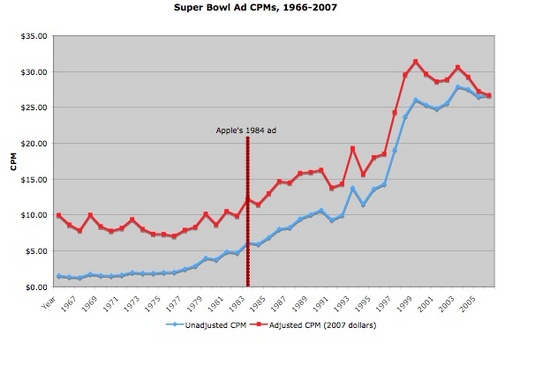In my previous post on advertising and the Super Bowl, I observed that household share has been flat for this major American cultural event since the late 1990s, but the actual number of viewers has increased almost every year. I wanted to share some more insight with you regarding the data from Super Bowls throughout history.
CPMs for Super Bowl Ads have been climbing, especially since the late 1990s.
More people are watching the Super Bowl, but CPMs (the cost of reaching one thousand viewers) have been growing, in nominal and real terms, quite rapidly since the late 1970s (before cable and the Internet) and took off in the late 1990s.
I marked Apple's 1984 ad on the chart below because that is the commercial that many people have argued started the trend towards Super Bowl ads becoming part of the event. It was directed by Ridley Scott (fresh from helming Blade Runner), ran 60 seconds long, and had a cinematic style as well as a striking Orwellian theme. It really was meant to be talked about.
That said, I don't think that the Super Bowl as a creative showcase that single-handedly drove the higher prices. CPMs were picking up speed in the years before the Apple ad, whether you look at the blue line, which represents nominal (unadjusted) dollars or the red line, which represents adjusted amounts in 2007 dollars.
I would guess that the increase has more to do with the improving economy, the advent of better cable and satellite TV and the appearance of the internet and video games as alternative mediums that were pulling viewers away from television in the late 1990s. Even though the prices are likely tied to the overall health of the economy, which wasn't good early in the 1990s or 2000s, CPMs have clearly increased substantially in the last twenty years.
Engagement and commercials
It makes intuitive sense that Super Bowl viewers are more engaged in the commercials because they are part of the fun of the event. So, my question is, why can't we make commercials less repetitive and more a fun part of watching television?
One thing that this year's ads demonstrated for me was that high production values and special effects help, but they aren't necessary. What struck me this year about the ads I liked was that they had a single, clever or funny premise that stuck out in my mind. And really, sometimes the production values just weren't necessary to convey that message. The overproduced ads without a good underlying concept were by far the worst.
Although duplicating the audience size for the Super Bowl may not be possible, could we engage audiences more in commercials by making them part of the event for other popular programs that happen around cultural milestones.
Of course, the C3 ratings and murmurs from NBC about doing away with fall premieres and the up fronts complicate this, but could more buzz be created around other major TV events that are tied to cultural milestones with the same characteristics as the Super Bowl? It means more focused expenditures on creative a few times a year, but it might be worth it to get the message across to an increasingly nimble audience resistant to commercial messages.
What about fall premiere week, which directly follows on back to school season? The Macy's Thanksgiving Day parade? March Madness and spring break? Or, you could even create "TiVo-proof" new TV events around the so-called "Hallmark holidays," like Valentine's Day and Halloween? If broadcasters and marketers got together to create those events and made them regular, compelling, and important to the audience to watch live and in groups (not because the networks say so), there may still be a mass audience to be had.
Unfortunately, comments are still down on the blog, but please email me at ecbaird@mit.edu.
Stay tuned.





